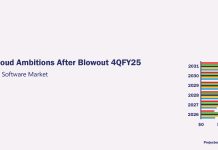
Five months ago, I asked a roomful of SAP executives what did it take for the ERP applications vendor to win in Customer Relationship Management, where it has been lagging behind the market leader Salesforce.
SAP CEO Bill McDermott was unabashed in his desire to unseat Salesforce because he believed his rival doesn’t have the foundational support of an in-memory database to store, track and analyze all kinds of customer interactions.
With the June unveiling of the C/4HANA products that include Hybris for Sales Force Automation and eCommerce, Gigya for Customer Identity Management, CallidusCloud for Sales Performance Management, and Coresystems for Field Service Management, McDermott and Alex Atzberger, president of SAP Customer Experience, expect all these applications will feed into the SAP HANA database, allowing brand owners to generate a 360-degree view of their customers, figure out the best channel to reach them and ultimately be able to enhance their experiences by hearing and incorporating their feedback into the customer lifecycle.
The Sunday announcement of SAP’s plan to pay $8 billion in cash to acquire Qualtrics, which is considered the frontrunner in the Enterprise Experience Management applications market, will round out the missing piece of its Customer Experience offerings.
During the conference call with investors, McDermott signaled that it was not only a bold move, but also a defining moment because SAP users will be able to better understand what their customers are looking for not just at the moment, but also in the not too distant future by simply surveying them for their direct feedback.
McDermott cites an example of Under Armour, a big SAP user, will be able to engage with their customers on what kind of athletic shoe design will capture their fancy by simply reaching out to them via the Under Armour app – now leveraging Qualtrics – and instantly getting their thumbs up or down.
Ryan Smith, CEO of the 16-year-old Qualtrics, said among its base of 9,000 customers, 685 key accounts such as Under Armour spend at least $100,000 annually on use of Qualtrics software to conduct online surveys, gather instant feedback and finally generate valuable insights on their customers.
SAP is paying dearly for such insights, about 21.5 times of Qualtrics’ projected revenues of $372 million for 2018. By comparison, Salesforce paid $6.5 billion for Mulesoft for Cloud integration in May at a similar ratio of 16x and IBM is paying nearly 10x Red Hat’s expected annual revenues for 2019 by shelling out $33 billion in its biggest purchase ever. Another point of reference was SAP’s biggest deal – its $8.3-billion acquisition of Concur for its travel and expense management applications in 2014. Back then, the ratio was 11.8 times of Concur revenues of $703 million for fiscal 2014.
Few things stand out in the megadeal between SAP and Qualtrics.
First the extravagant prices that these young companies like Qualtrics (founded in 2002 by Ryan and his father Scott, a Brigham Young University professor who first built the underlying technology while going through throat cancer treatment) and Mulesoft (founded in 2006) are able to fetch underscore the fact that they are key ingredients in what we call the Build Two phase of the enterprise software market.
During the Build One phase, major enterprise software companies are split into two groups. The first group includes early leaders like Microsoft for Windows, IBM for iSeries (still the workhorse of corporate computing), Oracle for database and SAP for ERP. The second group covers Amazon for its Cloud infrastructure successes, Google for search and Salesforce for CRM.
While the first group excelled at laying the foundation for data management, applications integration and global software implementation, the latter managed to leapfrog them by becoming more creative with their pricing (freemium for Google Search, Gmail, etc.) and hyperaggressive with their sales and marketing efforts (Dreamforce from Salesforce has become almost like a religious experience) and finally partner-centricity (AWS with its one million developers and customers in a thriving ecosystem that feeds on each other’s strength).
During the Build One phase, growth is the lowest common denominator that almost defies imagination – sometimes at the expense of margins and earnings, as shown in Table 1 that shows the trajectories of the seven key vendors over the past decade.

| $ In Millions | Latest Fiscal Year Net Income | 2008 Net Income | Latest Fiscal Year Operating Income | 2008 Operating Income | Latest Fiscal Year Revenues | 2008 Revenues |
|---|---|---|---|---|---|---|
| Amazon | 3033 | 476 | 4106 | 655 | 177866 | 14835 |
| Oracle | 3825 | 5521 | 13679 | 7844 | 39831 | 22430 |
| Microsoft | 16571 | 17681 | 35058 | 22492 | 110360 | 60420 |
| 12662 | 4204 | 15403 | 5084 | 110855 | 16594 | |
| Salesforce | 127 | 18 | 7706 | 577 | 10480 | 749 |
| IBM | 5753 | 10418 | 11400 | 14489 | 79139 | 98786 |
| SAP | 4876 | 2825 | 5864 | 3991 | 28205 | 14957 |
Table 1 – Comparing Earnings, Operating Income and Revenues Of Seven Major Cloud Vendors Between 2008 and 2018
Compared with the rich valuation awarded to Amazon (which topped $1 trillion earlier this year before its recent drop), Google and Salesforce because of their robust growth in sales and margins over the past decade, IBM, Oracle and SAP are considered the underperformers.
Both IBM and SAP are now resorting to huge acquisitions to fuel their growth in the Build Two phase, while Oracle is banking on steep discounts and increased sales and marketing spending to drive its new products including the Oracle Autonomous Database and its Oracle Cloud Infrastructure.
The Build Two phase will look very different. Whereas Amazon, Google and Salesforce will continue to grow at double-digit rates over the next few years, their growth will decelerate because of the law of the big numbers. The question is whether they will be able to grow their margins and earnings as well or follow the similar trajectory of the other four, as shown in Table 2.

For SAP in particular and IBM, Microsoft, Oracle in general, these are a few issues that they need to address if they want to succeed in Build Two.
- Are they willing to trade margin erosion and bottom line squeeze for top-line growth?
When selling Concur, SuccessFactors and now Qualtrics, chances are SAP will be extremely aggressive in pricing as long as customers are going to pick up SAP HANA, S/4 HANA and C/4 HANA. The key is that these acquired assets could become loss leaders so that the SAP core apps will remain the standard operating system at these customers.
- Can SAP win in CRM?
After buying Qualtrics, SAP owns plenty of choice properties in the CRM apps market. Still, it’s likely that it will need to shore up the marketing automation piece. Also, buying a customer service and support vendor like Zendesk could make SAP more palatable for someone that fits the profile of a Salesforce buyer that favors a suite approach.
A more likely scenario is that ERP, CRM and HCM will bleed into each other creating a much bigger market. Already Salesforce has been widely used as the defacto HR system by companies that have a sizable sales operation or one with an army of contact agents. These organizations are using Salesforce not just for CRM, but also for functions like HR portal, HR service delivery and commission management. Similarly, Qualtrics can be used in surveying customers, employees and trading partners.
In the Build Two phase, it will be up to the customers to define what’s CRM, ERP, and HCM – no different from the thin line that now separates work or family time, or for that matter the use of Cloud services to recruit a business partner, contractor, employee, or even a customer. Software beauty will be in the eye of the beholder.
- What’s the future of Qualtrics within SAP?
Qualtrics will drive the C/4 HANA platform, strengthening the customer experience component in a tangible way. However, the future of Experience Management is likely to be on the front end, rather than the back end. Anyone can tell that the feedback one gives on Uber is at best forced or at worst a show of user fatigue. Does a gut reaction summarize the whole experience? Should repeat complaints from the same customer be given more attention than others? Can a brand owner truly use that piece of information to improve the overall experience for everyone?
To optimize the staggering value of Qualtrics, SAP may need to position it as the barometer of predictive sentiment in any new product and service introduction and development. Similarly, Qualtrics could become a new tool for crowdsourcing and even replace the polling mechanism in an election.
For enterprise software vendors, their Build Two phase will still be largely defined by revenue growth. As the easy money era comes to a close with central banks tightening their monetary policies, real and meaningful profitability could matter much more. And that’s the balance all of them have to strike in order to achieve the best possible customer experience.





